
Nemattanew (also spelled Nemattanow; died 1621 or 1622) was a war leader of the Powhatan during the First Anglo-Powhatan War. At the time he served as a close adviser to paramount chief Opchanacanough (1554-1646).

Nemattanew (also spelled Nemattanow; died 1621 or 1622) was a war leader of the Powhatan during the First Anglo-Powhatan War. At the time he served as a close adviser to paramount chief Opchanacanough (1554-1646).
Nemattanew first appears in English colonial records in 1611, when George Percy mentioned 'Munetute' [ sic ] as being sent by paramount chief Wahunsunacawh, known as "Powhatan" to the colonists, to lead Indian resistance to the colonists' expansion in the upper James River region. This was when Henricus was founded, during the course of the First Anglo-Powhatan War. Percy notes that the colonists derisively called the leader "Jack-of-the-Feather", on account of his native war regalia, remarking that "he used to come into the field all covered over with feathers and swans' wings fastened unto his shoulders, as though he meant to fly". [1] [2]
Because Nemattanew was never wounded in these skirmishes, he began to believe he was supernaturally invulnerable to musket-fire. He persuaded his fellow tribesmen of this attribute, enhancing his reputation with them. [3] [4]
In the more peaceful times following the war, Nemattanew continued to play a prominent role. The colonists trained him to become a proficient musket shot. At one point in 1618, he raided an English colonial settlement, capturing some guns, but these were returned by Chief Opchanacanough. [5]
In 1619, Opchanacanough sent him to propose that the English colonists contribute eight to ten soldiers to accompany a Powhatan war party for an assault on a Siouan-speaking tribe above the Fall Line to avenge some Powhatan women they had slain. In return, the Powhatans would equally share all plundered captives, corn and territory with the colonists. This proposal was accepted by House of Burgesses; however, it failed to implement it by supplying the soldiers. [6] [7]
A short time before the Indian massacre of 1622, in which the Powhatan attacked Henricus, Nemattanew appeared at the home of settler Morgan. He saw some trading-trinkets and proposed taking Morgan to Pamunkey to gain a good price. Morgan was never seen again. A few days later, Nemattanew showed up at the plantation and announced Morgan's death. As he was wearing Morgan's hat, settlers suspected the Native American might have killed the settler. They tried to force him to go with them to the nearest magistrate, he resisted, and one of the colonists fatally shot him. As Nemattanew lay dying, he begged to be buried behind English lines and not to reveal to his people that he had been felled by English gunfire.[ citation needed ]
In England, John Smith, who had not been in Virginia since 1609, wrote in his 1624 Generall Historie of Nemattanew's death as occurring two weeks before the Henrico massacre. But 20th-century historian Rountree says, based on contemporary documents, particularly Council in Virginia, that it occurred no later than November 1621, while George Yeardley was still governor. This was five months before the massacre. There is some evidence in this document that by 1621, Nemattanew had fallen out of favor with Opchanacanough. Modern historians debate the nature of Nemattanew's true role in this event. They agree that the massacre was already being planned before he died, rather than being in reaction to his death at the hands of English colonists.[ citation needed ]

The Colony of Virginia was a British colonial settlement in North America from 1606 to 1776.
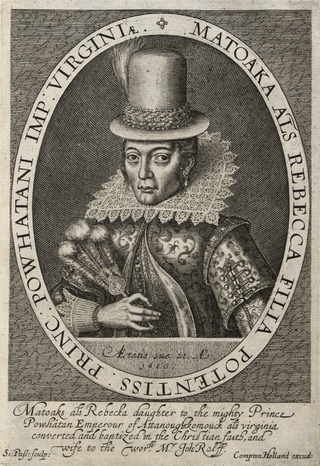
Pocahontas was a Native American woman belonging to the Powhatan people, notable for her association with the colonial settlement at Jamestown, Virginia. She was the daughter of Powhatan, the paramount chief of a network of tributary tribes in the Tsenacommacah, encompassing the Tidewater region of what is today the U.S. state of Virginia.

The Powhatan people are Indigenous peoples of the Northeastern Woodlands who belong to member tribes of the Powhatan Confederacy, or Tsenacommacah. They are Algonquian peoples whose historic territories were in eastern Virginia.

Opechancanough was paramount chief of the Powhatan Confederacy in present-day Virginia from 1618 until his death. He had been a leader in the confederacy formed by his older brother Powhatan, from whom he inherited the paramountcy.

Powhatan, whose proper name was Wahunsenacawh, was the leader of the Powhatan, an alliance of Algonquian-speaking Native Americans living in Tsenacommacah, in the Tidewater region of Virginia at the time when English settlers landed at Jamestown in 1607.
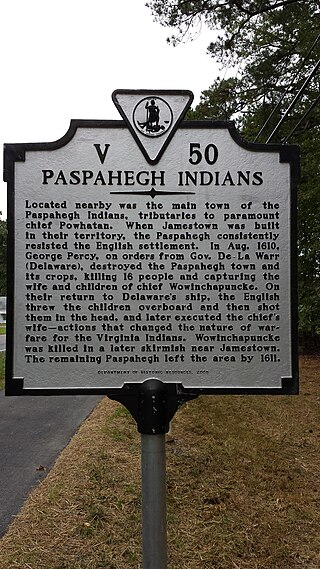
The Paspahegh tribe was a Native American tributary to the Powhatan paramount chiefdom, incorporated into the chiefdom around 1596 or 1597. The Paspahegh Indian tribe lived in present-day Charles City and James City counties, Virginia. The Powhatan Confederacy included Indigenous peoples of the Northeastern Woodlands who spoke a related Eastern Algonquian languages.
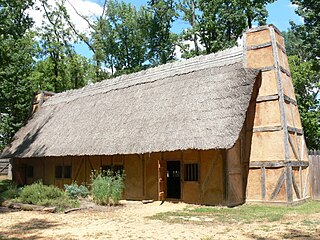
The "Citie of Henricus"—also known as Henricopolis, Henrico Town or Henrico—was a settlement in Virginia founded by Sir Thomas Dale in 1611 as an alternative to the swampy and dangerous area around the original English settlement at Jamestown, Virginia. Named for Henry, Prince of Wales (1594–1612), the eldest son of King James I, Henricus is located on a former curl of the James River about 12 miles southeast of the modern city of Richmond, Virginia or 15 miles from the fall line of the James River.
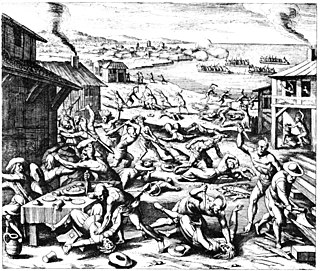
The Indian massacre of 1622 took place in the English colony of Virginia on March 22, 1621/22 (O.S./N.S.). English explorer John Smith, though he was not an eyewitness, wrote in his History of Virginia that warriors of the Powhatan "came unarmed into our houses with deer, turkeys, fish, fruits, and other provisions to sell us"; they then grabbed any tools or weapons available and killed all English settlers they found, including men, women, and children of all ages. Opechancanough, chief of the Powhatan Confederacy, led a coordinated series of surprise attacks that ended up killing a total of 347 people — a quarter of the immigrant population of the Colony of Virginia.
The Pamunkey Indian Tribe is a federally recognized tribe of Pamunkey people in Virginia. They control the Pamunkey Indian Reservation in King William County, Virginia. Historically, they spoke the Pamunkey language.

The Rappahannock are a federally recognized tribe in Virginia and one of the eleven state-recognized tribes. They are made up of descendants of several small Algonquian-speaking tribes who merged in the late 17th century. In January 2018, they were one of six Virginia tribes to gain federal recognition by passage of the Thomasina E. Jordan Indian Tribes of Virginia Federal Recognition Act of 2017.
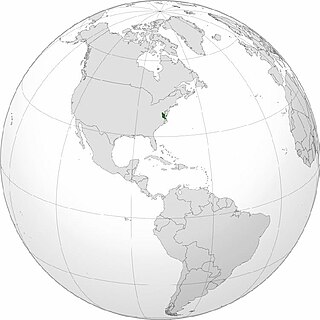
Tsenacommacah is the name given by the Powhatan people to their native homeland, the area encompassing all of Tidewater Virginia and parts of the Eastern Shore. More precisely, its boundaries spanned 100 miles (160 km) by 100 miles (160 km) from near the south side of the mouth of the James River all the way north to the south end of the Potomac River and from the Eastern Shore west to about the Fall Line of the rivers.

The Anglo–Powhatan Wars were three wars fought between settlers of the Colony of Virginia and the Powhatan People of Tsenacommacah in the early 17th century. The first war started in 1609 and ended in a peace settlement in 1614. The second war lasted from 1622 to 1632. The third war lasted from 1644 until 1646 and ended when Opechancanough was captured and killed. That war resulted in a defined boundary between the Indians and colonial lands that could only be crossed for official business with a special pass. This situation lasted until 1677 and the Treaty of Middle Plantation which established Indian reservations following Bacon's Rebellion.
Necotowance was Werowance (chief) of the Pamunkey tribe and Paramount Chief of the Powhatan Confederacy after Opechancanough, from 1646 until his death sometime before 1655. Necotowance signed a treaty with the Colony of Virginia in 1646, at which time he was addressed by the English as "King of the Indians."
Don Luís de Velasco, also known as Paquiquino, and also simply Don Luis, was a Native American, possibly of the Kiskiack or Paspahegh people, from the area of what is now Tidewater, Virginia. In 1561 he was taken by a Spanish expedition. He traveled with them ultimately to Spain, Cuba, and Mexico where he was baptized as "Luís de Velasco" and educated. Don Luís returned to Virginia in 1571 as guide and interpreter for a party of Jesuit missionaries. He is believed to have taken part in a later massacre of the Jesuits at this site, when the region was struggling with famine.

Berkeley Hundred was a Virginia Colony, founded in 1619, which comprised about eight thousand acres (32 km2) on the north bank of the James River. It was near Herring Creek in an area which is now known as Charles City County, Virginia. It was the site of an early documented Thanksgiving when the settlers landed in what later was the United States. In 1622, following the Indian Massacre of 1622, the colony was for a time abandoned. In the mid 18th century, it became known as Berkeley Plantation, the traditional home of the Harrison family of Virginia. In 1862, amid fighting in the Civil War, the area was the scene of the creation and first bugle rendition of present-day "Taps".
The Appomattoc were a historic tribe of Virginia Indians speaking an Algonquian language, and residing along the lower Appomattox River, in the area of what is now Petersburg, Colonial Heights, Chesterfield and Dinwiddie Counties in present-day southeast Virginia.

Jamestown, also Jamestowne, was the first settlement of the Virginia Colony, founded in 1607, and served as the capital of Virginia until 1699, when the seat of government was moved to Williamsburg. This article covers the history of the fort and town at Jamestown proper, as well as colony-wide trends resulting from and affecting the town during the time period in which it was the colonial capital of Virginia.
George Thorpe, was a noted landowner, Member of Parliament, distiller, educator and major investor in early colonial companies in the Americas.

Opossunoquonuske was a Weroansqua of an Appomattoc town near the mouth of the Appomattox River. Weroansqua is an Algonquian word meaning leader or commander among the Powhatan confederacy of Virginia coast and Chesapeake Bay region. She was known as the queen of Appamatuck, The community she led was large enough to provide an estimated twenty warriors to the Powhatan Confederacy.
This is a timeline of events related to the settlement of Jamestown, in what today is the U.S. state of Virginia. Dates use the Old Style calendar.